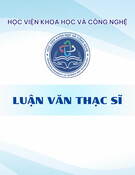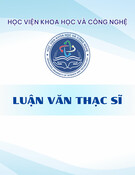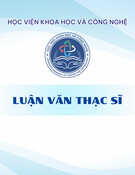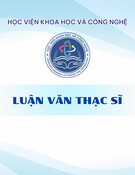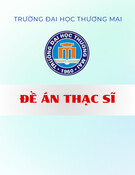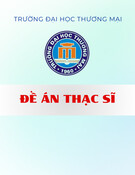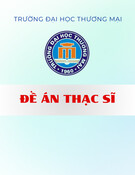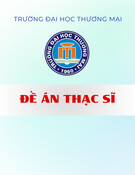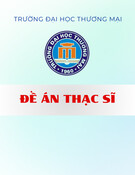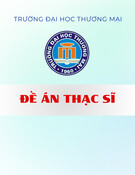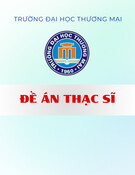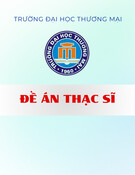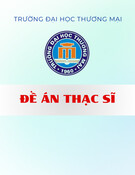
MINISTRY OF EDUCATION
AND TRAINING
VIETNAM ACADEMY OF
SCIENCE AND TECHNOLOGY
GRADUATE UNIVERSITY OF SCIENCE AND TECHNOLOGY
PHAN THANH PHƢƠNG
RESEARCH ON THE DEVELOPMENT OF ANALYTICAL
METHOD FOR METHYL MERCURY IN BIOLOGICAL AND
ENVIRONMENTAL SAMPLES IN THAN SA GOLD MINE,
THAI NGUYEN
Major: Analytical Chemistry
Code: 9.44.01.18
SUMMARY OF DOCTORAL THESIS IN CHEMISTRY
HANOI - 2019

The work was completed at:
Graduate University of Science and Technology – Vietnam
Academy of Science and Technology
Scientific advisors: 1. Assoc. Dr. Vu Duc Loi
2. Assoc. Dr. Le Lan Anh
Reviewer 1:………………………………………………
Reviewer 2:………………………………………………
Reviewer 3:……………………………………………….
The thesis will be defended in front of Academy-level Doctoral
Committee at: Graduate University of Science and Technology –
Vietnam Academy of Science and Technology
At … hour … date… month … year 2019
Thesis can be further referred at:
- The Library of Graduate University of Science and Technology
- National Library of Vietnam

LIST OF PUBLICATIONS
1. Vũ Đức Lợi, Dương Tuấn Hưng, Nguyễn Thị Vân, Phan Thanh
Phƣơng, “Phân tích thủy ngân oxit (HgO) và thủy ngân sunfua
(HgS) trong trầm tích thuộc lưu vực sông Nhuệ và sông Đáy”,
Tạp chí phân tích Hóa, Lý và Sinh học, 2015, Tập 20 (4), 135-142
2. Mineshi Sakamoto, Nozomi Tatsuta, Kimiko Izumo, Phuong
Thanh Phan, Loi Duc Vu, Megumi Yamamoto, Masaki
Nakamura, Kunihiko Nakai, Katsuyuki Murata, "Health Impacts
and Biomarkers of Prenatal Exposure to Methylmercury: Lessons
from Minamata, Japan", Toxics, 2018, 6 (3), 45
3. Vu Duc Loi, Duong Tuan Hung, Phan Thanh Phuong, “Mercury
pollution due to gold mining activities in Thai Nguyen province”,
Food Control Conference 2018, 4-5th October 2018, Hanoi,
Vietnam.
4. Vũ Đức Lợi, Dương Tuấn Hưng, Nguyễn Thị Vân, Phan Thanh
Phƣơng. “Nghiên cứu phương pháp xác định hàm lượng metyl
thủy ngân trong mẫu sinh học bằng phương pháp quang phổ hấp
thụ nguyên tử kỹ thuật hóa hơi lạnh (CV - AAS)”, Tạp chí phân
tích Hóa, Lý và Sinh học, 2019, Tập 24 (3), 111-117.
5. Phan Thanh Phƣơng, Vũ Đức Lợi, Dương Tuấn Hưng, Nguyễn
Thị Vân. “Đánh giá mức độ ô nhiễm metyl thủy ngân trong trầm
tích suối Nước Đục thuộc xã Thần Sa, huyện Võ Nhai, tỉnh Thái
Nguyên”, Tạp chí phân tích Hóa, Lý và Sinh học, 2019, Tập 24
(3), 123-129.

1
INTRODUCTION
Environmental pollution is a global problem that is concerned by all
countries and many scientists. Among the pollutants present in the
environment, heavy metals, especially mercury, play an important role in
the processes of transformation and bioaccumulation, when penetrating
into the body, heavy metals will cause a great negative impact on human
health, so they are considered as one of the causes of cancer and other
serious diseases. Mercury toxicity depends on its speciation; organic
mercury is more toxic than inorganic mercury and the most toxic form of
mercury is methyl mercury (CH3Hg+), which accumulates in fish and
animal cells. Methyl mercury is soluble in fat, the fat fraction of
membranes and in the cerebrospinal fluid. The most dangerous property
of methyl mercury is its ability to move across the blood - brain
membrane and penetrate into the fetal tissue through the placenta.
There have been many cases of mercury poisoning occurring on a large
scale in the world. During 1953 - 1960 in Minamata City, Japan about
2955 people had been poisoned with mercury. Among those infected, 45
died. Genetic defects have been observed in newborn children whose
mothers ate seafood harvested from the bay. In 1972, in Iraq, 459 farmers
died after ingesting pesticides contaminated with mercury.
Mercury is used in many industries such as chemicals, fertilizers,
plastics, electrical engineering, electronics, paint, gold splitting in placer
ores, manufacture of fluorescent lamps, batteries, thermometers,
sphygmomanometer, cosmetics… According to a report of the Vietnam
Chemical Agency - Ministry of Industry and Trade, in 2016, Vietnam
had 4 main industries related to mercury use and emissions, including
the manufacture and use of lighting equipment, burning coal from the
factory, using it in the field of health and artisanal and small-scale gold
mining, our country annually emits about 49,131 kg of mercury into the
environment.
In the environment, mercury is transformed into its other speciation
by the activities of nature and humans, mercury is released into the
atmosphere by various sources, then dispersed and deposited into land,
mercury is stored and metabolized in soil and water.
Biological conversion of inorganic mercury compounds to methyl
mercury compounds can occur in sediments, in water, and in organisms.
The process of mercury methylation is the most important factor that
contributes to the introduction of mercury into the food chain. Artisanal
and small-scale gold mining uses metal mercury to create amalgams, but

2
methyl mercury has been discovered in sediments in the mining area.
The transformation of mercury speciation in the gold mining area is very
complicated, the research on methylation and bioaccumulation of
mercury in fish and benthos in these areas is limited. On the other hand,
there is no manual procedure for methyl mercury analysis in sediments
and biological samples in Vietnam.
Therefore, we have chosen the thesis research entitled “Research on
the development of analytical method for methyl mercury in biological
and environmental samples in Than Sa gold mine, Thai Nguyen”.
The objectives of the thesis are:
- Research to develop an analytical method for methyl mercury in
biological samples with high sensitivity, selectivity, and accuracy.
- Research and assessment of the transformation and bioaccumulation
of mercury in sediment and biological samples in Than Sa gold mining
area, Vo Nhai district, Thai Nguyen province.
To achieve above objectives, the main research contents of the
thesis include:
- Investigate, select optimal conditions and validate the method of
determination of total mercury in sediment and biological samples.
- Research, select optimal conditions and validate the method of
determination of methyl mercury in sediment by the gas chromatography
with electron capture detector (GC-ECD).
- Research, investigate and develop the analytical procedure for the
determination of methyl mercury in biological samples by atomic
absorption spectroscopy - improved cold vapor technique combined with
liquid-liquid extraction techniques.
- Apply the developed analytical procedure to determine the total
mercury and methyl mercury in sediment, biological samples in Than Sa
gold mining area, Vo Nhai district, Thai Nguyen province and assess the
transformation and accumulation of mercury in the above samples.
CHAPTER 1. OVERVIEW
1.1. Mercury in nature and the cause of environmental pollution
1.1.1. Mercury in nature
1.1.2. Transformation cycle of mercury in the environment
1.1.3. Application of mercury
1.1.4. Causes of mercury pollution in the environment
1.2. Property of mercury

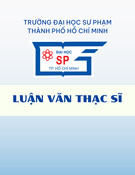

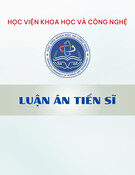
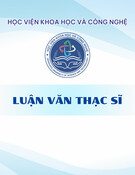
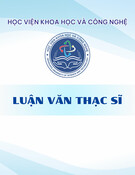
![Luận văn Thạc sĩ: Tổng hợp và đánh giá hoạt tính chống ung thư của hợp chất lai chứa tetrahydro-β-carboline và imidazo[1,5-a]pyridine](https://cdn.tailieu.vn/images/document/thumbnail/2025/20250807/kimphuong1001/135x160/50321754536913.jpg)
